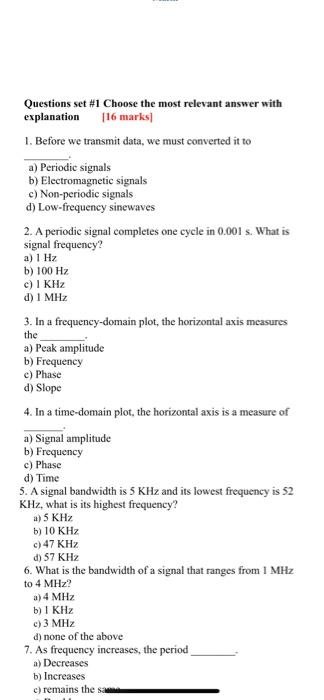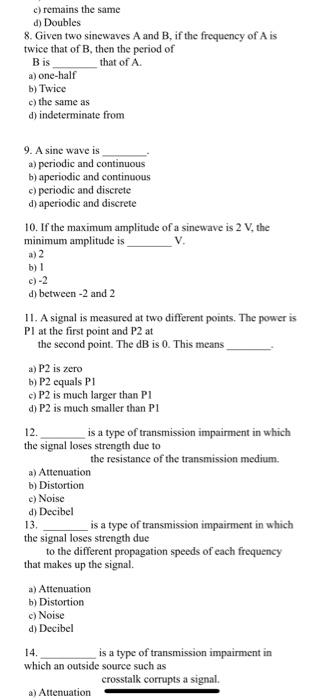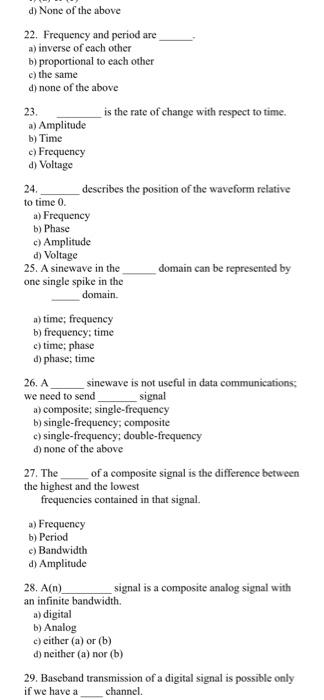b) Bandpass c) low rate d) high rate 31. For a channel, Nyquist bitrate formula defines the theoretical maximum bitrate. a) Noisy b) Noiseless c) Bandpass d) low-pass 32. For a channel, we need to use Shannon capacity to find maximum bitrate. a) Noisy b) Noiseless c) Bandpass d) low-pass Questions set #2 Solve the following problems. 14 marks 1. The output power of a microwave-transmitting antenna is 200mw at 5GHz. What is the output power expressed in dBm? (Ipt.) 2. If the bandwidth of a signal is 150 MHz and its lowest frequency is 695MHz, what is the highest signal frequency? (1 pt.) 3. A Spectrum of a channel is between 3 MHz and 4 MHz has a SNR of 24dB. Find, a) The maximum data rate that can be achieved. (Ipt.) b) The required signaling levels and number of bits per level. (Ipt.) Answers Ass-1_ICEN 212 Spring 2020/2021 10 Questions set #1 Choose the most relevant answer with explanation 116 marks 1. Before we transmit data, we must converted it to a) Periodic signals b) Electromagnetic signals c) Non-periodic signals d) Low-frequency sinewaves 2. A periodic signal completes one cycle in 0.001 s. What is signal frequency? a) 1 Hz b) 100 Hz c) I KHz d) 1 MHZ 3. In a frequency-domain plot, the horizontal axis measures the a) Peak amplitude b) Frequency c) Phase d) Slope 4. In a time-domain plot, the horizontal axis is a measure of a) Signal amplitude b) Frequency c) Phase d) Time 5. A signal bandwidth is 5 KHz and its lowest frequency is 52 KHz, what is its highest frequency? a) 5 KHz b) 10 KHz c) 47 KHz d) 57 KHz 6. What is the bandwidth of a signal that ranges from 1 MHz to 4 MHz? a) 4 MHz b) I KHz c)3 MHZ d) none of the above 7. As frequency increases, the period a) Decreases b) Increases c) remains the sa c) remains the same d) Doubles 8. Given two sinewaves A and B, if the frequency of Ais twice that of B, then the period of Bis that of A. a) one-half b) Twice c) the same as d) indeterminate from 9. A sine wave is a) periodic and continuous b) aperiodic and continuous c) periodic and discrete d) aperiodic and discrete 10. If the maximum amplitude of a sinewave is 2 V, the minimum amplitude is a) 2 b) c)-2 d) between-2 and 2 11. A signal is measured at two different points. The power is PI at the first point and P2 at the second point. The dB is 0. This means a) P2 is zero b) P2 equals P1 c) P2 is much larger than P1 d) P2 is much smaller than PI 12. is a type of transmission impairment in which the signal loses strength due to the resistance of the transmission medium. a) Attenuation b) Distortion c) Noise d) Decibel 13 is a type of transmission impairment in which the signal loses strength due to the different propagation speeds of each frequency that makes up the signal. a) Attenuation b) Distortion c) Noise d) Decibel 14. is a type of transmission impairment in which an outside source such as crosstalk corrupts a signal. a) Attenuation d) Decibel is a type of transmission impairment in which an outside source such as crosstalk corrupts a signal. a) Attenuation b) Distortion c) Noise d) Decibel 15. When propagation speed is multiplied by propagation time, we get the a) Throughput b) wavelength of the signal c) distortion factor d) distance a signal or bit has traveled 16. Data can be a) Analog b) digital c) (a) or (b) d) none of the above 17. data are continuous and take continuous values. a) Analog b) Digital c) (a) or (b) e) none of the above 18, data have discrete states and take discrete values. a) Analog b) Digital c) (a) or (b) d) None of the above 19. Signals can be a) Analog b) Digital c) either (a) or (b) d) neither (a) nor (b) 20. signals can have an infinite number of values in a range a) Analog b) Digital c) (a) or (b) d) None of the above 21. signals can have only a limited number of values. a) Analog b) Digital c)(a) or (b) d) None of the above d) None of the above 22. Frequency and period are a) inverse of each other b) proportional to each other c) the same d) none of the above 23. is the rate of change with respect to time. a) Amplitude b) Time c) Frequency d) Voltage 24. describes the position of the waveform relative to time 0. a) Frequency b) Phase c) Amplitude d) Voltage 25. A sinewave in the domain can be represented by one single spike in the domain. a) time; frequency b) frequency, time c) time; phase d) phase, time 26. A sinewave is not useful in data communications, we need to send signal a) composite; single-frequency b) single-frequency, composite c) single-frequency, double-frequency d) none of the above 27. The of a composite signal is the difference between the highest and the lowest frequencies contained in that signal. a) Frequency b) Period c) Bandwidth d) Amplitude 28. A(n) signal is a composite analog signal with an infinite bandwidth. a) digital b) Analog c) either (a) or (b) d) neither (a) nor (b) 29. Baseband transmission of a digital signal is possible only if we have a channel











